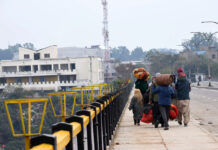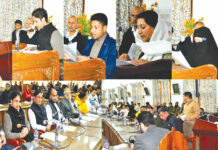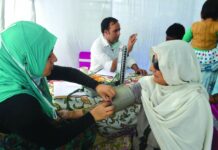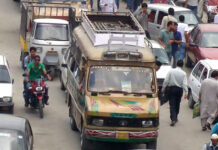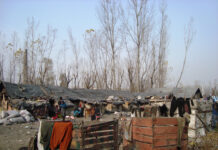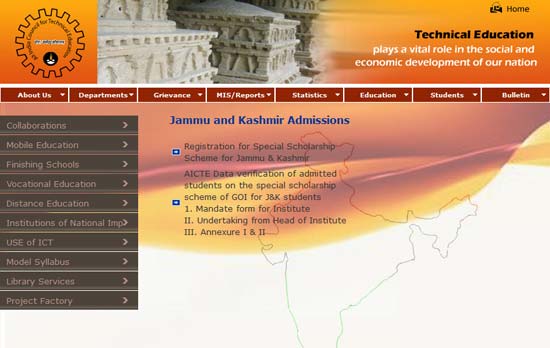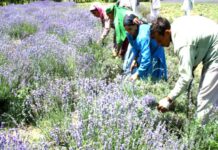Women have come out on the streets in large numbers to join protests. Aliya Bashir looks into the factors that forced homemakers on to the streets.
When her 26-year-old son was battling for his life in SKIMS Hopistal after being shot in his leg, the 50-year-old, Rehati (name changed) confronted the visiting chief minister. The grief-stricken mother threw her sandal at the CM, which hit one of his guards.
The chief minister was visiting the SK Institute of Medical Sciences to see the injured admitted in the hospital for the first time since the cycle of killings.
Rehati is not the only woman taking a lead in raising voice against killings. The last few weeks have seen women out on streets marching with, sometimes ahead, of men with a message – kill us before you kill our young boys and girls.
 Until now, she was a seen as a silent sufferer, an eternal witness in houses that overlook the streets of protest. But now the women protestors carry edgy stones in their hands.
Until now, she was a seen as a silent sufferer, an eternal witness in houses that overlook the streets of protest. But now the women protestors carry edgy stones in their hands.
In the past two months of unrest, an unfamiliar new photograph of the Kashmiri women is making headlines on the front pages of the newspapers.
Neither is a women protestor veiled in black from head to toe nor is she seen campaigning for her party. She is dressed in a typical shalwar- kameez and their head is casually covered with a dupatta. She doesn’t pay any heed of being recognized.
In this conflict zone, she is even casted as victim, wailing and silent spectator at the endless funeral procession. But now time has changed and so has she. Irrespective of her age and background, she is armed with a stone directed against the khakhi-men.
Earlier men and youth were protesting whenever there was a killing, but the trend seems to have changed now. If there is a killing, women of all age groups take a lead.
Like Rehati, Nusrat is another women protestor. “We have suffered silently for the past two decades. We have always protested silently. Yet our youth are being maimed, tortured and killed ruthlessly. Now it’s getting on our nerve, that’s why we don’t hesitate from pelting stones,” said Nusrat a resident of Batamaloo.
“We are left with no option. Whenever we try to give vent to our feelings, we protest peacefully. But in return they open fire on us,” she added.
In one of the simmering Fridays, the women protesters stopped two Air Force vehicles, asked the security personnel and their family to disembark before the vehicles were set afire. The women, however, ensured that nobody was hurt.
There are some women, who feel that this conflict has made them stronger with the state resorting to bullets, batons, curfews and iron hands to hush-up the probes.
“This occupation has made us strong. The reason is that a mother has lost her son, a sister her brother and a wife has lost her husband. So, I think all these things have made us even stronger,” said Mehbooba Mufti, who is party leader of People’s Democratic Party.
“Being a woman I equally feel the pain. We actually relate to each other with this relation of pain and better understand the price of being a woman in Kashmir,” Mufti said.
As bodies pile up, and more mothers wail on their dead sons, there are women who stand with a sense of determination and say “sacrifices won’t go in vain”.
“If a woman’s political activism is not given a space. Then we cannot say that this is a people’s movement, then it is a men’s movement,” says separatist Zamrooda Habib.
Since the cycle of protests Zarmooda is in hiding and occasionally comes out to see her ailing mother.
Similar vibes are synchronising across Kashmir as women say it is not the responsibility of men alone to protest against injustice.
“When we have shouldered coffin of our young and innocent sons who fell to troopers’ bullet, why should not we come on streets. We are living in constant fear that today it was Fancy Jan, tomorrow it can be me,” said Mehmooda Nazir, 27, a neighbour of Fancy Jan in Batamaloo. “It is better to fight against the atrocities; to fight for Azadi.”
Fancy Jan, 24, was killed by a bullet, when she was trying to fix the curtains of the window of her room to prevent tear gas smoke from entering. She turned away from the window and said “Mummy mae aaw heartas fire,” (Mother, a bullet has pierced my heart) recalls her mother Khateeja. “I lifted her scarf and blood was oozing out of a hole as the bullet had pierced through her heart.”
Fancy was not a stone-pelter. She was the first woman killed in the ongoing unrest that has claimed over 60 lives since June 11. She was one among the four killed in police firing on the same day.
“Initially I was against protests. They affect the livelihoods of thousands. But, when Aisha Begum was not spared by these unruly cops irrespective of her age and gender, then why should we be reluctant to come on the forefront,” said Firdousa Bashir, 50, a resident of Basant Bagh.
Aisha Begum, 55-year-old resident of Nai Sadak in Basant Bagh was hit by a stone on August 6 when she had ventured out of her home at 8:30 pm to buy milk. She later succumbed to her injuries at SKIMS on August 7. Aisha was the third women to die in the recent protests.
 Women who are joining the chorus of protests and stone-pelting in the current wave of pro-freedom protests want to express their solidarity with those women who lost their sons and daughters. They are aware that they can meet the same fate. Yet, they move on.
Women who are joining the chorus of protests and stone-pelting in the current wave of pro-freedom protests want to express their solidarity with those women who lost their sons and daughters. They are aware that they can meet the same fate. Yet, they move on.
Syeda Afshana, who teaches at Media Educational Research Centre, Kashmir University, said that the increasing female presence reflects the sense of injustice felt by Kashmiris. “Out on the streets, women are making their minds felt. By pelting stones, they are expressing their collective anger,” Afshana said.
Asiya Andrabi, Chief of Dukhtaran-e- milat, a woman’s group said that there is urgent need of restoration of peace and security for the safety and security of women in Kashmir.
“The present spate of killings in which even women are not spared have exposed the state puppet government which is spilling the blood of Kashmiris. There is every obvious reason for women to come on streets,” Asiya said. “We are being butchered to give voice to our atrocities.”
She said that there is an immediate need for all the women to join hands to fight against the naked aggression of the police and paramilitary CRPF.
On August 1, another 18-year-old girl, Afroza Teli, daughter of Ghulam Muhammad Bhat fell to paramilitaries’ bullets. Afroza was killed when police fired on a group of protestors in Khrew. Afroza’s killing sparked violent protests in the area with people setting fire to the police station.
While female protestors are also dealt with force in Kashmir, sometimes brutal, paramilitary men says dealing these is a challenge. “Putting women and children in the front of rallies is a deliberate attempt by separatists to put us on back foot,” Prabhakar Tripathi, spokesman for paramilitary Central Reserve Police Force (CRPF). “They know we won’t confront them,” he said.
While a few women dare to pelt stones, others chip in by raising slogans, and fetching water to youth protestors.
Nighat Shafi Pandit chairperson of the aid group HELP foundation says the rights violation have brought women out on the streets. “We have been suffering from last twenty years now. We want our girls to walk the streets without any fear. But, they are killing us at will. All these human rights violation are bringing women on streets.”


